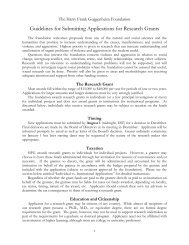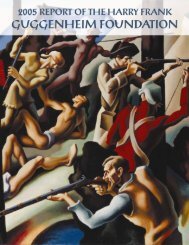Small Arms and Light Weapons - Harry Frank Guggenheim ...
Small Arms and Light Weapons - Harry Frank Guggenheim ...
Small Arms and Light Weapons - Harry Frank Guggenheim ...
- No tags were found...
You also want an ePaper? Increase the reach of your titles
YUMPU automatically turns print PDFs into web optimized ePapers that Google loves.
ers. Global civilian gun ownership is much greaterthan military or police arsenals: approximately 55per cent of known global stockpiles are owned bycivilians, with 41 per cent held by the military <strong>and</strong>3 percent by police. This lopsided ratio poses aformidable challenge to the state monopoly offorce. Typical civilian ownership is 10-15 guns per100 residents, <strong>and</strong> typical gun owners have roughlythree guns each. The United States is home to thelargest share of the civilian firearms pool.Theft, pilferage, <strong>and</strong> loss release large numbersof small arms. Indeed, global theft accounts forat least one million missing guns each year.Catastrophic loss of control can release enormousnumbers. Albanian state authorities lost approximately640,000 small arms in 1997 when the economy<strong>and</strong> then the government collapsed. In Iraq,at least four million guns went missing in 2003after the US-led invasion. Despite the overwhelmingimportance of stockpile management, many ofthe world’s official institutions do not have reliableinformation on small arms possession in theircountries.Our underst<strong>and</strong>ing of how to regulate <strong>and</strong> manageexisting arsenals to minimize the risks is stillpoor. A prominent example is disarmament—ahighly visible <strong>and</strong> politically important instrumentfor dealing with small arms proliferation—<strong>and</strong> itseffects. In the above-mentioned example of disarmamentin Ethiopia, the reduction of arms inEthiopian military h<strong>and</strong>s contributed to gun traffickingin the region. How can small arms disarmamentbe best achieved without producing counterproductiveeffects?A better underst<strong>and</strong>ing of small arms arsenalsaround the world would make it easier to determinethe source of arms used to intimidate,wound, <strong>and</strong> kill. Should research <strong>and</strong> policy focusprimarily on illegal small arms, as in the UNprocess to combat small arms trafficking, or shouldthey encompass legal small arms as well? Whenshould civilian firearms ownership be regulated ordenied? Many guns are essentially invisible <strong>and</strong>unlikely to be involved in causing any direct harm.Some simply collect dust for years on end. Othersare extremely dangerous. What distinguishes theleast dangerous guns from their most deadly counterparts?Can regulation distinguish between thosesmall arms least likely <strong>and</strong> those most likely to beabused?<strong>Arms</strong> TransfersToday, there is a fairly good knowledge base onthe value of government-authorized (“legal”) tradeof small arms <strong>and</strong> light weapons between Westerncountries. The picture of authorized transfers fromWestern states to the rest of the world is also fairlyclear, although, unsurprisingly, details of some ofthe more controversial <strong>and</strong> secretive deals stillelude us. According to the latest available data <strong>and</strong>estimates, the largest small arms exporters by valueare the United States, Italy, Belgium, Germany, theRussian Federation, Brazil, <strong>and</strong> China. Theworld’s largest importers are the United States,Saudi Arabia, Cyprus, Japan, South Korea,Germany, <strong>and</strong> Canada. The authorized trade insmall arms <strong>and</strong> light weapons is worth an estimatedUSD 4 billion per year.There is still only a patchy underst<strong>and</strong>ing of theauthorized trade of many of the big actors outsidethe Western world, especially the Russian Federation<strong>and</strong> China. Transactions of many smallernon-Western exporters are also poorly documented.Hence, there are countries that are knownto be medium producers of small arms but aboutwhose exports we know virtually nothing. Theseinclude such countries as Iran, Pakistan, <strong>and</strong>Singapore.The production of weapons by a firm in onecountry under license by a company in anothercountry, known as licensed production, is underresearched,as is the trade related to it. Licensedproduction is particularly important to underst<strong>and</strong>because companies can evade their own national28




